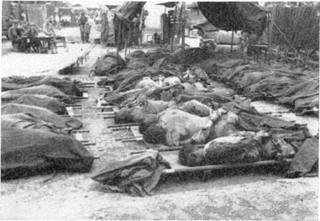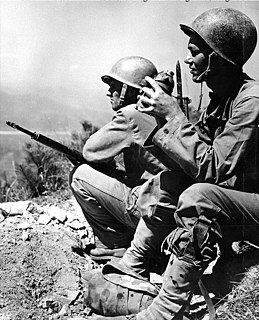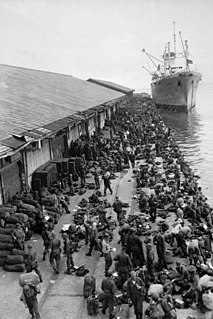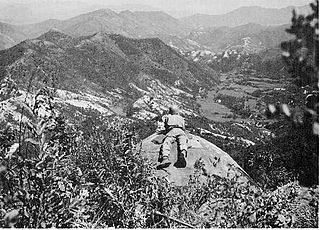 W
WThe Battle of the Pusan Perimeter was a large-scale battle between United Nations Command (UN) and North Korean forces lasting from August 4 to September 18, 1950. It was one of the first major engagements of the Korean War. An army of 140,000 UN troops, having been pushed to the brink of defeat, were rallied to make a final stand against the invading Korean People's Army (KPA), 98,000 men strong.
 W
WThe Battle of Battle Mountain was an engagement between United Nations Command (UN) and North Korean forces early in the Korean War from August 15 to September 19, 1950, on and around the Sobuk-san mountain area in South Korea. It was one of several large engagements fought simultaneously during the Battle of Pusan Perimeter. The battle ended in a victory for the UN after large numbers of United States Army (US) and Republic of Korea Army (ROK) troops were able to prevent a Korean People's Army (KPA) division from capturing the mountain area.
 W
WIn the Battle of the Bowling Alley , United Nations Command (UN) forces defeated North Korean forces early in the Korean War near the city of Taegu, South Korea. The battle took place in a narrow valley, dubbed the "Bowling Alley", which was north of Taegu. It followed a week of fighting between the Korean People's Army (KPA) 13th Division and the Republic of Korea Army's (ROK) 1st Division along the latter's last defensible line in the hills north of the city. Reinforcements, including the US Army's 27th and 23rd Infantry Regiments were committed to bolster the ROK defenses. This battle and several others were smaller engagements of the Battle of Pusan Perimeter.
 W
WThe Great Naktong Offensive was a North Korean military offensive against United Nations Command (UN) forces early in the Korean War, taking place from September 1–15, 1950. It was the North Korean Korean People's Army (KPA)'s unsuccessful final bid to break the Pusan Perimeter established by the UN forces.
 W
WThe Battle of Haman was one engagement in the larger Battle of Pusan Perimeter between United Nations Command (UN) and North Korean forces early in the Korean War from August 31 to September 19, 1950, in the vicinity of Haman County in South Korea. The engagement ended in a victory for the UN after large numbers of United States Army troops repelled a strong Korean People's Army (KPA) attack on the town of Haman.
 W
WThe Hill 303 massacre was a war crime that took place during the opening days of the Korean War on August 17, 1950, on a hill above Waegwan, South Korea. Forty-one United States Army (US) prisoners of war were shot and killed by troops of the North Korean People's Army (NKPA) during one of the numerous smaller engagements of the Battle of Pusan Perimeter.
 W
WThe Battle of Ka-san was an engagement between United Nations Command (UN) and North Korean forces early in the Korean War from September 1 to September 15, 1950, in the vicinity of Ka-san in South Korea. It was a part of the Battle of Pusan Perimeter, and was one of several large engagements fought simultaneously. The battle ended in a victory for the United Nations after large numbers of United States Army (US) and Republic of Korea Army (ROK) troops repelled a strong Korean People's Army (KPA) attack.
 W
WThe Battle of Kyongju was an engagement between United Nations Command (UN) and North Korean forces early in the Korean War from August 31 to September 15, 1950, in the vicinity of Kyongju in South Korea. It was a part of the Battle of Pusan Perimeter, and was one of several large engagements fought simultaneously. The battle ended in a victory for the UN after large numbers of United States Army (US) and Republic of Korea Army (ROK) troops repelled a strong North Korean Korean People's Army (KPA) attack.
 W
WThe Battle of Masan was an engagement between United Nations Command (UN) and North Korean forces, which took place early in the Korean War between August 5 and September 19, 1950, in the vicinity of Masan and the Naktong River in South Korea. It was part of the Battle of Pusan Perimeter, and was one of several large engagements fought simultaneously. The battle ended in a victory for the UN after large numbers of United States Army (US) troops were able to repel the repeated attacks of two Korean People's Army (KPA) divisions.
 W
WThe First Battle of Naktong Bulge was an engagement between United Nations Command (UN) and North Korean forces early in the Korean War from August 5–19, 1950 in the vicinity of Yongsan and the Naktong River in South Korea. It was a part of the Battle of Pusan Perimeter, and was one of several large engagements fought simultaneously. The battle ended in a victory for the UN after large numbers of US reinforcements destroyed an attacking North Korean division.
 W
WThe Second Battle of Naktong Bulge was an engagement between United Nations Command (UN) and North Korean forces early in the Korean War from September 1 to September 15, 1950, along the Naktong River in South Korea. It was a part of the Battle of Pusan Perimeter, and was one of several large engagements fought simultaneously. The battle ended in a victory for the United Nations after large numbers of United States Army (US) troops repelled a strong Korean People's Army (KPA) attack.
 W
WThe Battle of Nam River was an engagement between United Nations Command (UN) and North Korean forces early in the Korean War from August 31 to September 19, 1950, in the vicinity of the Nam River and the Naktong River in South Korea. It was a part of the Battle of Pusan Perimeter, and was one of several large engagements fought simultaneously. The battle ended in a victory for the United Nations after large numbers of United States Army (US) troops were able to repel a Korean People's Army (KPA) attack across the river.
 W
WThe Battle of P'ohang-dong was an engagement between the United Nations Command (UN) and North Korean forces early in the Korean War, with fighting continuing from 5–20 August 1950 around the town of P'ohang-dong, South Korea. It was a part of the Battle of Pusan Perimeter, and was one of several large engagements fought simultaneously. The battle ended in a victory for the UN after their forces were able to drive off an attempted offensive by three North Korean Korean People's Army (KPA) divisions in the mountainous eastern coast of the country.
 W
WLogistics in the Battle of Pusan Perimeter during the Korean War played a decisive role in the battle. Efficient logistics, the management of personnel and materiel, supported United Nations (UN) supply lines while the North Koreans' routes of supply were steadily reduced and cut off. UN logistics improved throughout the Battle of Inchon and the defeat of the North Korean army at Pusan.
 W
WThe Battle of Tabu-dong was an engagement between United Nations Command (UN) and North Korean forces early in the Korean War from September 1 to September 18, 1950, in the vicinity of Tabu-dong, north of Taegu in South Korea. It was a part of the Battle of Pusan Perimeter, and was one of several large engagements fought simultaneously. The battle ended in a victory for the UN after large numbers of United States Army (US) and Republic of Korea Army (ROK) troops repelled a strong Korean People's Army (KPA) attack.
 W
WThe Battle of Taegu was an engagement between United Nations Command (UN) and North Korean forces early in the Korean War, with fighting continuing from August 5–20, 1950 around the city of Taegu, South Korea. It was a part of the Battle of Pusan Perimeter, and was one of several large engagements fought simultaneously. The battle ended in a victory for the UN after their forces were able to drive off an offensive by Korean People's Army (KPA) divisions attempting to cross the Naktong River and assault the city.
 W
WThe Battle of Yongsan was an engagement between United Nations Command (UN) and North Korean forces early in the Korean War from September 1–5, 1950, at Yongsan in South Korea. It was part of the Battle of Pusan Perimeter and was one of several large engagements fought simultaneously. The battle ended in a victory for the UN after large numbers of United States Army (US) repelled a strong Korean People's Army (KPA) attack.